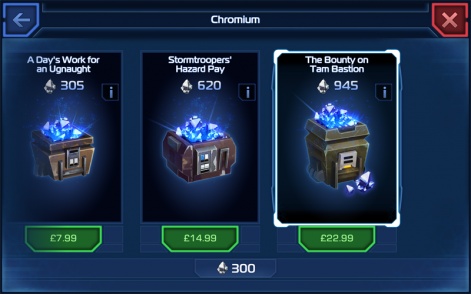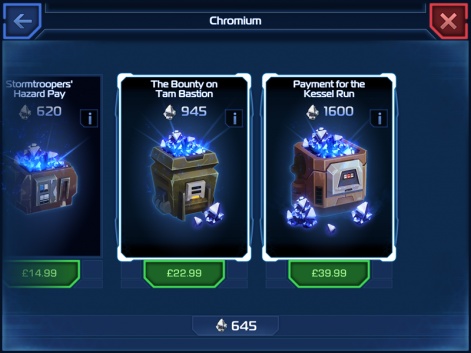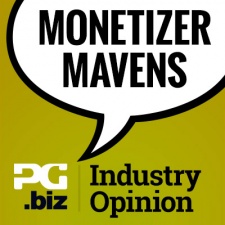When free-to-play games burst onto the scene, there was lots of experimentation in the techniques and mechanics of monetisation.
There were plenty of tricks and tips to be attempted, but as the market has matured, so standards have arisen.
Which made it interesting to see that the first time you access the IAP store in Kabam's Star Wars: Uprising, the maximum bundle displayed is $29.99.
However, if you buy that bundle, a higher priced item is then shown, and so on up to $99.99.
So we asked our Monetizer Mavens:
- Do you think this sort of UX has any impact in terms of overall monetisation, or is it more of a clever psychological trick to stop some players getting scared the first time they enter the game store?
We have been testing similar things, and there is a measurable impact on a cohort's monetization performance.
Showing the highest price point package first in a shop that is sorted left-to-right does increase average transaction size, showing the lowest price point first increases conversion rate.
But: this seems to be different per game. Either audiences react differently, or behavior changes over time (e.g. the market/audience "learns" certain standards).
Promotions are more interesting than the IAP sorting/display rules.Justin Stolzenberg
Promotions are more interesting than the IAP sorting/display rules. Clash of Clans and some other games aren't doing hard currency discounts/ promotions.
A typical argument against running individual or community-wide sales is that they anchor players on a too low price point, i.e. cannibalize both immediate and future ARPPU more than the additional conversion makes up for.
On the other hand games like Game of War or Clash of Kings are running discounts all the time.
The argument for running promotions (in a way like they set it up) is that a higher number of players converts and the difference in short-term ARPPU can be over compensated by offering further upselling discounts only for price points that are higher than the user would usually consider.
If a player buys $49,99 (discounted from $99.99) instead of $9.99 (regular price) as a second package after having converted on a $4.99 USD (discounted from $9.99 or even $19.99) it's a net positive for us.
What has made most sense to us is to run extensive multivariate tests.

With over 15 years’ data mining experience, Mark co-founded deltaDNA, formerly GamesAnalytics, to unlock big data to drive player understanding, introducing the concept of Player Relationship Management to build better games.
Kabam are thinking beyond the first purchase to give players compelling reasons to invest more.Mark Robinson
I used to work in retail and we only started selling $150 shoes when we added $200 shoes to the rack.
Most whales make many medium sized purchases relative to the range on offer and start purchasing early in their gameplay so this strategy may dampen this revenue stream from these guys.
But it seems a smart move for other players who are tempted to take the first purchasing step… starting small and building up.
The nice thing about this approach is that Kabam are thinking beyond the first purchase to give players compelling reasons to invest more in the game because of the perceived benefits.
It's not something that usually can be delivered in one go… but overall a few touchpoints.
Many games will immediately show you 6-to-9 price point options ranging from $0.99 to $99.99 when you enter their hard currency store.
In Mike Hine’s article, “What Top 50 Games Do With In-App Purchasing That the Rest of Us Don’t”, he shows us data where games with more price point options will see less revenue.
When there are too many options the player is going to have a tough time discerning value in each of the packages. And when a player is unsure which package is best for them they will not make a purchase. Nobody wants to feel buyer’s remorse.
I think Star Wars: Uprising’s decision to keep the store small and then revealing variety in price points once the player becomes a payer is a good one.

However, I am curious as to how dynamic and targeted their IAP store is when it realizes you are a payer?
Slowly revealing a higher and higher price point package based on whether I made the top purchase makes sense if I am the type of player that likes to spend big. Because that makes sense. If I am willing to part with $29.99, it’s not a stretch for me to drop $49.99.
What if I am the type of player that is open to just spending $4.99 once a week? Am I eventually going to see a higher price point option because after several months I would have spent a total of $100?
Or instead of showing me the $99.99 package in hopes of getting me to take the plunge, maybe that space used to show me another $4.99 deal that would be of interest to get me to spend $4.99 twice a week?

Jordan Blackman is a lead designer and producer with over ten years of experience designing, producing, and managing hit content for companies like Zynga, Ubisoft, NovaLogic, & Disney.
Over 80 million people have played games that Jordan worked on as either a producer or designer.
Jordan’s credits include Lead Designer on FrontierVille & CastleVille, Senior Producer and Original Concept on CSI: Crime City (Facebook), Producer on Delta Force: Black Hawk Down, and Writer on Joint Operations: Typhoon Rising.
It almost certainly impacts overall monetization.
You might call these "Goldilocks" offerings because there is a range of prices that will be ideal for a customer at a given point in their lifecycle, so make adjustments and keep things tuned to what's "just right" for them.
Of course, there is no reason to simply assume it works - split test the technique and ensure it gives a good result in your product.

I wonder what could be done with the low end of the offers. Reduce the lowest price offering for players who visit the store but don't buy…
Then again, since players often choose the middle option, perhaps there is some interesting variations to be tested there.
It's hard for me to imagine the difference between $49.99 and $99.99 having a measurable impact on retention (scared players churning), but maybe it's part of a larger effort to create a F2P game that won't tarnish the Star Wars brand.
So far, it seems they've succeeded.

Jero is a very business oriented and entrepreneur-spirited game developer focusing on combining game design, business and marketing.
CAUTION: If you engage this person with topics of game marketing or monetization, just clear your schedule for rest of the day.
Even if this is a very small experiment, I think it is following correct path.
Players vary from non-spenders to whales, with huge variety of different motivation levels required to get them converted.
Best way to optimize monetization is to understand those different motivation levels.Jero Juujärvi
Best way to optimize monetization is to understand those different motivation levels. To understand them, you first have to convert them. Offering individuals custom discounts, bonuses or "goldilocks" is good way to do it.
After they have made their first purchase, you should know what level of motivation is required for player to convert. After that, your game only need to offer custom pricing/offers for players as continuity program to keep them monetized and engaged.
This all, of course, must be designed with care to avoid customer revolt that some airline companies has faced previously.
I believe conversion almost always wins short term ROI: only time when it doesn't win is when you sell low quality products.
I really like this approach and hope we see a lot more of it.
Freemium games have a great opportunity to deliver tailored experiences to players because of our ability to measure (and react to) player behavior instantly.
Presenting dynamic IAPs ... ultimately delivers a more customized experience.Jon Walsh
To deliver the right experience you have to qualify players and to qualify players you have to be able to present and test things like offers.
Presenting dynamic IAPs based on player progression and spending pattern ultimately delivers a more customized experience that means the player spends less time looking at things that they're not interested in buying.
This is a great start and I'm sure we'll see publishers continue to increase their sophistication around dynamically presenting not only IAPs but also virtual goods, custom bundles, and more based on how a player is playing a game.

























